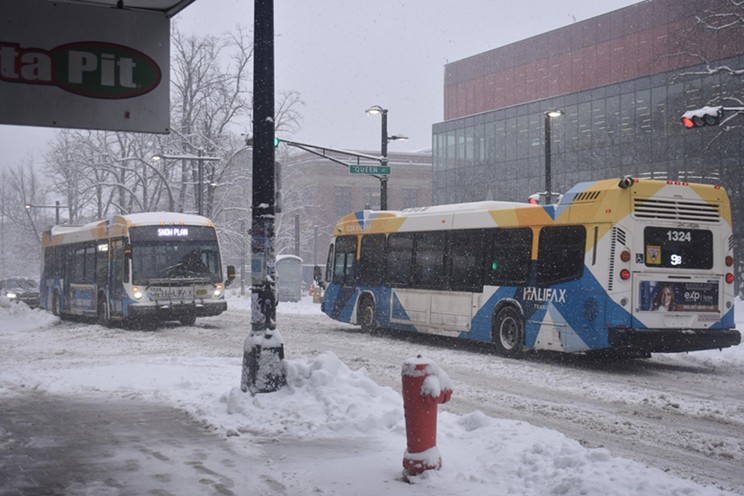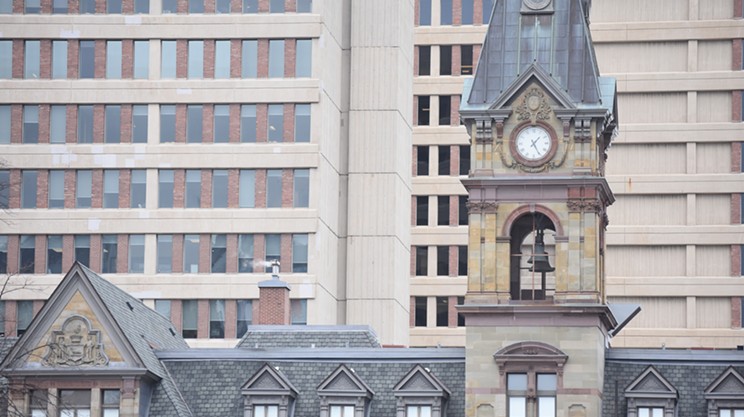It was not bad news across the board. Transit seems to have fixed its hiring issues and is now trying to staff up to make up for past staffing shortages. The Access-A-Bus service is getting some love this year. And because this will allow more people with mobility issues to access an Access-A-Bus bus, it should mean fewer instances of regular buses needing to stop and labouriously “kneel,” making it easier for buses to stay on time. But beyond a bit of a mixed bag of proposed route changes, that’s where the good news about the future of transit ends.
At the start of the meeting, like the start of all budget meetings, the public is given an opportunity to speak. Douglas Wetmore, of transit advocacy group It’s More Than Buses, told councillors that they need to push back against the inertia of Halifax Transit’s decision making, because departmental decisions just aren’t making a lot of sense. He told the committee that Transit’s plan to bring back express routes that were cut during the pandemic should be stopped; the express routes never caught on, so this a chance to let them die and focus instead on getting more buses on high-ridership routes in high-ridership corridors that are currently experiencing delays and overflows. These corridors, with better service, would form the spine of the transit network, which would increase reliability and provide expanded commuter services as people learned that they could drive into a hub in Cole Harbour or Bedford or Lower Sackville, and could then reliably bus into downtown in half an hour like if they drove. This would help move large volumes of passengers during peak periods. This could be strengthened by reducing or eliminating low-ridership services, like those express routes.
He was followed by member of the public Min Tan, who wants Halifax Transit to be more aspirational in its planning. He pointed out that Halifax Transit’s ridership targets, when adjusted for population, were lower in this fiscal year (2023/24) than last fiscal year (22/23). He also pointed out that even though Halifax Transit was planning to increase its level of service, it expected buses to be emptier as a result. This, Tan suggested, pointed to a lack of ambition in Transit planning, as more frequent and reliable transit service should lead to fuller buses. He said that maybe, just maybe, Halifax Transit should make its budget like it thinks any number of the city's many strategic transportation planning exercises are going to be successful.
After the public spoke, the director of Halifax Transit, Dave Reage, gave his presentation, fielded questions and explained to the assembled councillors why Halifax Transit has yet to integrate any of council’s mobility planning.
Councillor Pam Lovelace picked up on Tan’s line of questioning from the top of the meeting and asked Reage why our budget wasn’t aspirational. Reage explained that aspirational budgeting, also known as budgeting for the success of strategic plans, is not the role of a budget document. But it should be noted that this approach to budgets is not uniform in Halifax’s municipal departments. For example, later on in the same committee meeting, the new Department of Community Safety presented a budget that was almost entirely aspirational spending, or requests for aspirational spending, because they are trying to achieve the stated strategic goals their department is responsible for. It’s not clear why the same ethos can’t apply to Dave Reage’s Halifax Transit.
Councillor Waye Mason then asked why Transit isn’t doing something like what It’s More Than Buses is suggesting, and increase capacity in corridors we know are busy and overcrowding. Reage explained that this type of change is too large a scope for a budget debate, and if councillors want to see that type of spending they need to change their strategic plans to reflect that. The only problem with that response is that the suggestion from IMTB’s Douglas Wetmore is precisely the current direction Dave Reage is supposed to be following according to the very first paragraph of the Moving Forward Together Plan’s guiding principles, which reads as follows (emphasis in original):
The Moving Forward Together Plan increases the proportion of resources allocated towards high ridership services by establishing ten high ridership Corridor Routes that form the spine of the transit network, providing expanded commuter focused services to move large volumes of passengers during peak periods, providing coverage service in off-peak periods, and by reducing or eliminating low ridership services. The plan also includes performance measures intended to provide direction related to the level of ridership expected, and measuring the success of the routes described in this plan should be focusing on adding capacity.
If Halifax’s existing strategic plans aren’t affecting Halifax’s Transit current spending, it’s unclear what Reage thinks will be different with the next strategic plan telling him to do the same thing. Hopefully we’ll get an explanation when Mason’s motion to find out what it would take to correct Transit’s budget and follow the city’s strategic plans comes back for the Budget Adjustment List debates.
The other major flaw in Halifax’s transportation and mobility planning came up when councillors Tim Outhit and Kathryn Morse turned the conversation to fares and ridership. The main thrust of the argument came from Outhit, who wanted to know why we are punishing people for taking transit. We charge people property tax, more if they live within 1km of a bus stop. And we charge people fares. Triple taxation! So doesn’t increasing fares punish people for doing something we want them to be doing?
The answer is maybe. The tradeoffs in fare-recovery policies vary widely, and as a result Reage told councillors this decision would have to be a political one. Regardless of politics his department needs more money, about $700,000, so they are proposing a fare hike of 25 cents on every bus ride. “Do you want that on the fare or do you want that on the tax rate?” Reage asked Outhit. But in a city with integrated transportation planning there are way more options than fare collection or tax rate: We can change user fees, too.
For example, last year when the city was trying to find money to fund the community safety program, the Department of Public Works came up with an easy way to make about $700,000. DPW told councillors that charging drivers a fee of $2 an hour to rent public infrastructure for private vehicle storage—that is, a new fee for parking—would generate a predicted $717,249 this budget year. With the city’s new parking enforcement tech coming this summer, when including parking tickets, that $717,249 of potential transit funding from automotive infrastructure is likely an underestimation. But the budget as currently proposed still has the fare increase planned for September.
And finally, councillor Kathryn Morse wanted some updates on the city’s planned Bus Rapid Transit system. Reage explained that the main hold-up on BRT was waiting on the funding for automotive subsidies. Since Halifax isn’t interested in replacing automotive infrastructure with bus infrastructure it needs to buy about $100 million worth of land to indulge the destructive violence of our vehicle-centred culture (which is also causing congestion). The good news is that there are federal funds available that the city is applying for.
Morse also wanted to know how to increase ridership. Reage explained that investing in core services like the BRT or expanding the ferry makes the network more reliable, which is the incentivization side of the policy equation for ridership growth. And people would ride transit more if it was a reliable way to see a friend after having a few beers, or was reliable enough for people to finally let go of their $1,300 a month tithe for transportation.
Something that would also massively increase ridership is to make policy choices that make driving infrastructure safe and convenient for non-car owners instead of quick and convenient for car owners. But since we see a $100-million-dollar driving subsidy as a necessity to prioritize transit like we said we were going to in 2016 and 2018 and 2021, don't hold your breath that this year will somehow magically be different. It’s one of the main Achilles heels of our current setup where we have a first-past-the-post popularity contest for power, in a world where everyone is dependent on the objectively worst mass transit option to get around.













